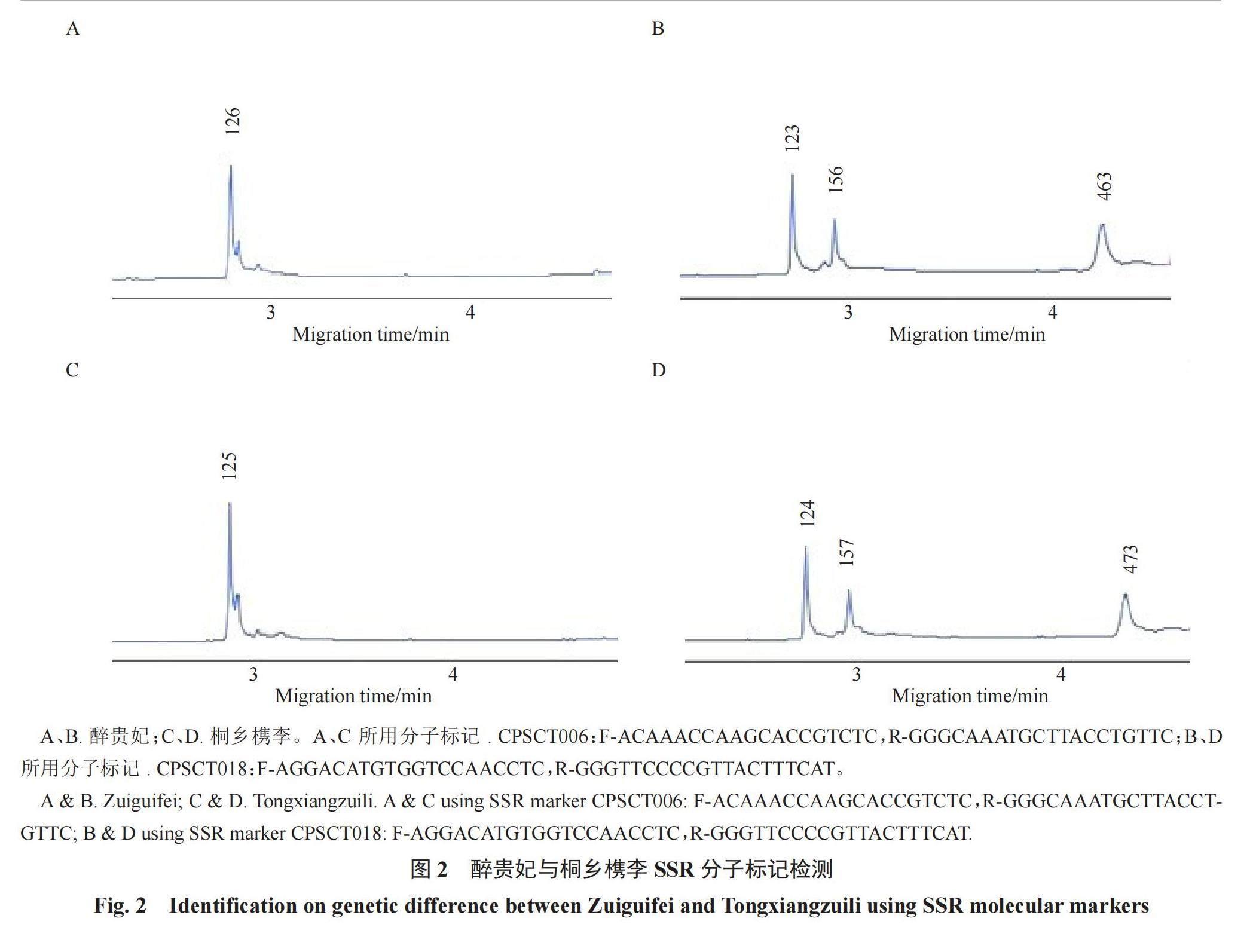晚熟槜李新品种醉贵妃的选育
2024-04-30谢小波李斌江挺李昊朱晨辉
谢小波 李斌 江挺 李昊 朱晨辉



摘 要:醉貴妃是从收集的槜李种质资源中选育出的晚熟槜李新品种。该品种在嘉兴地区一般7月上中旬成熟,有些年份在6月下旬成熟。醉贵妃结果性状好,产量稳定,成年树产量控制在9.0 t?hm-2左右即可;成熟时口感极佳,汁水丰富,符合槜李易化浆、可吸食特征;可溶性固形物含量(w,后同)16.0%左右,高达20%;果形大,平均单果质量69.5 g,呈扁圆形、较对称;成熟果实外皮深紫红色并密布灰白色果点,果肉黄色,黏核;少有细菌性穿孔病和流胶病;自交结果性较好,可单一品种种植;树姿稍显直立,需要拉枝并结合其他修剪措施塑造开心树形;进入结果期后以有机肥为主,需严格控制氮肥使用。该品种经多地试种,适宜在浙、赣、黔、川、渝、沪、苏等长江以南区域多省份种植。
关键词:中国李;槜李;新品种;醉贵妃;晚熟;桐乡槜李
中图分类号:S662.3 文献标志码:A 文章编号:1009-9980(2024)04-0786-05
Breeding of late-ripening Zuili variety Zuiguifei (Japanese plum)
XIE Xiaobo1, LI Bin2, JIANG Ting3, LI Hao4, ZHU Chenhui5
(1Horticulture Institute, Zhejiang Academy of Agricultural Sciences, Hangzhou 310021, Zhejiang, China; 2Agriculture and Fisheries Technology Promotion Station of Jiaxing City, Jiaxing 314050, Zhejiang, China; 3Agriculture Management and Service Centre of Jiaxing Nanhu District, Jiaxing 314001, Zhejiang, China; 4Forestry Technology Promotion Centre of Xinchang County, Xinchang 312500, Zhejiang, China; 5Fruit Trees and Silkworm Technology Promotion Station of Jiaxing Xiuzhou District, Jiaxing 314011, Zhejiang, China)
Abstract: Zuiguifei (Prunus salicina L.) was bred by systematic breeding method from Zuili germplasm collections. Zuili is one of Japanese plums, and has a high prestige in Chinese plum industry as one of the very delicious plums with the longest cultivation history of more than 2500 years at Jiaxing city, Zhejiang province, China. Zuiguifei was firstly found from a farmer yard in July, 1997 at Nanhu District, Jiaxing City. When the fruit was ripening, Mr. Lu found it. And it was late-ripening and 20 years old, with a good fruiting trait and a nice quality, comparing with other Zuili cultivars. Its branches were collected and were grafted on rootstocks, coded as J-31 in the winter of 1997. J-31 has an elite taste for its rich juice, high soluble solids content and aromatic smell. Its pulp is easy melting and could be sucked for eating when it matures. This is coincident with one of the typical characteristics of Zuili after maturity. There is a deep purple red peel covering with dense grey-white dots when J-31 fruits ripen with yellow flesh and clinging stone. Its fruit is oblate, more symmetrical and slightly big. J-31 was named as Guifei, which was borrowed from one title of ancient Chinese emperor wives, in 2018. We conducted the first-round variety test with Tongxiangzuili as the control from 2016 to 2018. Tongxiangzuili is a more popular cultivar of Zuili and generally matures around mid-June. As Tongxiangzuili often has a low yield with unstable fruit set, the new varieties are required to be bred. Experiments have showed Guifei fruits generally ripen in early July or mid-July at Jiaxing City, sometimes in late June also. Guifei has a higher yield than Tongxiangzuili. Guifei could be regarded as a late-ripening Zuili variety. Guifei was approved for a five-year field releasing by the Zhejiang Provincial Forestry Variety Committee with license No. ZHE-R-SV-PS-006-2019, and formally named as Zuiguifei in 2019. For getting a permanently field releasing approval for Zuiguifei, we carried out a new round variety test from 2021 to 2022 with Tongxiangzuili still serving as the control variety. Results showed that the whole fruit growth period of Zuiguifei was about 113 d from blooming to ripening. The variety test showed that the average yield of adult Zuiguifei trees was about 8.1 t·hm-2 with 37.3% increasing than that of the control Tongxiangzuili. Its average soluble solids content was about 16.0% with up to more than 20.0%. Its peel was slightly sour and the titratable acid content in flesh with skin was 1.03% while the pulp was only about 0.72%. The Vc content of Zuiguif was 8.01 mg·100 g-1 flesh. Its mean fruit weight was 69.5 g. There was no significant difference in the content of total soluble solids between Zuiguifei and Tongxiangzuili. Based on experience, it is recommended that its yield may be controlled to about 9.0 t·hm-2 by thinning flowers and young fruits as higher yield probably decreases fruit quality. Zuiguifei is resistant to bacterial perforation and gummosis. As it is self-compatible, Zuiguifei could be grown solely. Its tree is slightly upright and requires pulling branches or other pruning measures to shape an opening tree. Organic manures should be considered as main fertilizer resource and N needs to be limited for fruiting trees. Zuiguifei has been introduced and tested in many places and showed good adaptation in southern provinces of Yangtze River, e.g. Zhejiang, Jiangxi, Guizhou, Sichuan, Chongqing, Shanghai, Jiangsu etc.
Key words: Prunus salicina; Plum Zuili; New variety; Zuiguifei; Late maturation; Tongxiangzuili
槜李,也有写作醉李,是中国李(Prunus salicina L.)中的优质地方名李,口感极佳,原产于浙江嘉兴一带,距今有2500多年栽培历史。孔子著的《春秋》记载,公元前496年,“五月,於越败吴于槜李”,首次提到“槜李”两字,为地名。宋代诗人张尧同认为这一地名是由当地出产名李而来,是将果名用作了地名。清代王蓬辰专门撰写过《檇李谱》一书(1856—1857年),较详细地描述了槜李的特征特性,这是我国古籍中唯一对一种果树作谱的著作。1937年6月上海中央印刷公司出版了桐乡人朱梦仙先生著的新版《檇李谱》,他根据自己长期对槜李的观察提出了一些新见解,尤其对桐乡桃园槜李作了介绍。
槜李在长期的栽培过程中也积累了深厚的人文底蕴,最为突出的就是“西施爪痕”的民间传说,即槜李果顶部位常有一指甲宽裂痕,民间相传为西施在槜李园中品尝时留下的指甲印记。因此,从古至今当地人们视此特征的槜李果实为上佳果品。
槜李历来产量表现不佳,有大小年现象,因此,被认为自花结实存在问题,需要搭配亲和性好的授粉品种[1]。有研究发现槜李花粉的畸形率超过50%,有活力花粉比例为40%左右[2]。槜李在长期的栽培中出现了很多基因型,生产中往往混杂种植,因此需要通过育种手段筛选优良品种。以往也曾开展槜李品种的选育工作[3],同时对部分授粉品种及其S基因型做了鉴定[4],还对槜李在遗传上的特征也做了一些探索[5-6]。但是直到今天对槜李研究的投入仍然不足,生产中对槜李品种优质、稳产、耐贮运等性状的需求依然没有完全解决,醉贵妃的选育就是已有育种研究的一个延续。
醉贵妃是一个具有优良口感品质、可单一种植、产量稳定、适应性强的晚熟槜李新品种,从最初发现到获得认定历时超过20 a(年),是一个有较大潜力的优质李品种(图1)。
1 选育过程
1997年7月中旬,在嘉兴市南湖区南湖乡八字桥村徐金根家槜李园中发现1株7月份成熟槜李。树上果实分布均匀,结果性能良好,果形较大,果面紫红色,果粉较厚,味香甜、汁多,口感佳,果肉黄色,黏核,具有槜李易化浆特性。第二年春采集枝条用毛桃作砧木嫁接,同时在其他李树上高接。2000—2006年,通过连续多年进行栽培试验和观察并与其他近20个槜李种质资源进行比较,确认该株系具有突出的优良性状。
2009—2011年,在秀洲区王店镇建立新的示范基地。种植密度为:株距×行距为1.5 m×4.0 m,同时种植桐乡槜李和其他多个槜李品系,并以青杆毛桃为砧木进行嫁接繁殖。2016—2018年,以桐乡槜李为对照,在嘉兴市秀洲区、绍兴市新昌县和嘉兴市嘉善县三个基地开展对比试验。对比试验表明醉贵妃产量表现优异,稳产,较桐乡槜李晚熟约半个多月。2019年,获浙江省林木良种认定,认定编号:浙R-SV-PS-006-2019。2021—2022年,仍以桐乡槜李为对照,继续开展品种比较试验。多年比较试验表明,醉贵妃表现品质优,产量显著高于桐乡槜李,稳产(表1)。
包括醉贵妃在内,从表型上观察,苗期和生长期的槜李各类型间往往难以辨别。因此,笔者采用分子标记和毛细管电泳技术进行鉴定,并筛选出了若干个能区分醉贵妃、桐乡槜李和其他一些槜李种质资源的SSR分子标记(图2)。
2 主要性状
2.1 果实主要经济性状
醉贵妃口感佳,经农业农村部农产品及加工品质量安全监督检验测试中心(杭州)检测可溶性固形物含量(w,后同)为16.0%,可溶性糖含量为11.3%,带皮测定可滴定酸含量为1.03%,固酸比为15.5,与对照桐乡槜李相当;维生素C含量为8.01 mg?100 g-1。平均单果质量69.4 g,视疏果情况单果质量会有差异,部分果实单果质量80~90 g,最高可超过100 g;成年树(6 a以上)平均单位面积产量8.1 t·hm-2(6.1~12.2 t·hm-2),比对照桐乡槜李平均产量5.9 t·hm-2(3.6~9.8 t·hm-2)增产37.3%;嘉兴地区一般在7月上旬或中旬成熟,比对照桐乡槜李迟约15 d左右,采摘时间可持续15~20 d,随着后期气温升高,糖分积累也更高,果肉会有凝固现象,口感也会有所下降。
2.2 植物学特征
1年生树枝紫褐色或绿褐色,成年树树枝青灰色,树势中庸,树姿开张,以短结果枝和花簇状枝条结果为主。
叶倒卵圆形或椭圆形,叶尖渐尖,叶缘粗锯齿状。
花瓣5瓣,花白色,双子房花比例较高,有时高达20%,年度间有变化,花量大,成簇或成球、成串。通常3月中旬或下旬开花,花期一般7~10 d。
成年树在合理疏花疏果后,平均单果质量70 g,最高可达100 g。成熟果实底色黄绿,外皮不均匀分布深紫红色,并密布大小不等的灰白色果点,果粉中多;呈扁圆形,缝合线浅,两半部较为对称;果顶微凹陷,少部分有指甲狀裂痕(即民间流传的西施指甲印),梗洼中大;果肉橙黄色,成熟果实易化浆、可吸食,黏核,核仁常退化。
2.3 物候期
醉贵妃在嘉兴地区一般3月中旬开花,花期通常7 d左右,展叶期在4月上中旬,7月上旬或中旬成熟,有些年份会提早到6月下旬,落叶期在11月底。从始花到成熟的果实全发育期约113 d。
2.4 抗逆性
醉贵妃少有细菌性穿孔病和流胶病发生,同时有较强的耐涝和耐寒性。
3 繁殖方法及栽培技术要点
3.1 建园
选择地势高、光照好、避风、无涝害的地块建园,一般以南北向挖定植沟或定植穴,沟深40 cm以上、宽50 cm,定植穴可挖深度和直径60~80 cm,施好底肥,每666.7 m2施腐熟的有机肥2000~2500 kg、钙镁磷肥50 kg,肥料和种植土混匀后施入种植沟或种植穴,再覆厚度约20 cm的表土,一般要高出畦面15 cm左右,然后放苗,培土,浇透定根水,并将苗木扶正,露出嫁接口。果园需挖排水沟,尽量做到深沟高畦。
3.2 定植
可按行株距(5~6) m×(3~4) m定植,每666.7 m2栽28~44株。定干高度50~70 cm,视立地条件和机械使用要求而定,平地可比坡地高,考虑农机使用的情况可高定干。同时,可间种一些亲和性好、花期相近的其他李子品种,以提高坐果率。
3.3 肥水管理
幼树以施氮、磷、钾元素兼顾或氮肥含量高的肥料,促进快速生长。结果树必须以有机肥为主,增施钾肥,兼施中微量元素肥料。生长期特别是幼树期,可叶面喷施0.3%磷酸二氢钾。成龄果园可进行生草栽培,以抑制杂草生长,夏秋干旱时节可适当喷灌或滴灌,补充土壤水分。
3.4 整形修剪
一般以开心形为基本树形,可以为3~4主枝,也可以为2主枝Y形。槜李树新梢一般分为春梢、夏梢和秋梢,可在每次抽梢至50 cm时,进行摘心处理,经过第一年的三次摘心,至年底就可以形成较为丰满的树冠。冬季落叶后,采用自然开心形进行修剪,或培育Y形树形。要确保树势中庸,对弱树进行重短截,促进其生长;对旺树要轻剪疏枝,以缓和树势。夏季修剪以拉枝为主,调整枝条角度。
3.5 疏果管理
要做好疏花疏果管理,尤其是疏果,需2~3次,保证疏果到位、结果均匀,可按10~15 cm挂1个果,或30~40枚叶片结1个果进行衡量。
3.6 防霜冻
确保到初冬时完全落叶,一般要求95%叶片在秋末冬初时正常掉落(北方11月中旬,南方11月底)。晚霜危害是槜李落花落果的主要原因之一,如有寒流或霜冻,可于凌晨最低温时熏烟防霜,减少花和幼果霜害。
3.7 病虫害防治
冬剪后和萌芽前喷3~5 °Bé石硫合剂进行综合防治。春季开花前,可喷布吡虫啉或啶虫脒防治蚜虫;7—8月要防治红蜘蛛危害;6月下旬至7月下旬,防治刺蛾;开花前后可用含性诱激素的迷向丝,预防或减轻后期梨小食心虫危害。对李红点病,当病叶率为5%时,可喷布甲基托布津防治;对李软腐病,发现有0.5%以上病果时,可喷布代森锌可湿性粉剂防治。
3.8 果实采收
7月上中旬,在果实有1/3~3/4着色、七八成熟、口感较佳时,即可采收。传统产区较重视槜李的完美口感,可在8—9月成熟、果实略软时采,新产区建议在果实尚硬时采,以便于存放与运输。要分批采摘,并置于阴凉通风处,然后进行分级出售,快递寄运时建议用较软的材料进行单果包装。
参考文献 References:
[1] JIA H J,HE F J,XIONG C Z,ZHU F R,OKAMOTO G. Influences of cross pollination on pollen tube growth and fruit set in Zuili plums (Prunus salicina)[J]. Journal of Integrative Plant Biology,2008,50(2):203-209.
[2] 何風杰,贾惠娟,熊彩珍,顾立明. 两个不同成熟期槜李花粉育性和亲和性比较研究[J]. 中国南方果树,2011,40(5):19-21.
HE Fengjie,JIA Huijuan,XIONG Caizhen,GU Liming. Comparison on pollen fertility and compatibility of two ‘Zuili plum varieties of different maturing period[J]. South China Fruits,2011,40(5):19-21.
[3] 齐玉洁,贾惠娟,张丽平,李斌,熊彩珍. 2个槜李优系成熟过程中果实品质及生物活性物质的变化[J]. 浙江大学学报(农业与生命科学版),2014,40(5):505-510.
QI Yujie,JIA Huijuan,ZHANG Liping,LI Bin,XIONG Caizhen. Changes in quality characteristics and bioactive compounds of two “Zuili” plum (Prunus salicina Lindl.) superior lines during maturation[J]. Journal of Zhejiang University (Agriculture and Life Sciences),2014,40(5):505-510.
[4] 张树军,黄绍西,张绍铃,吴俊,衡伟,吴华清,宋宏峰. 槜李等15个李品种S基因型鉴定及其多态性分析[J]. 果树学报,2008,25(3):338-342.
ZHANG Shujun,HUANG Shaoxi,ZHANG Shaoling,WU Jun,HENG Wei,WU Huaqing,SONG Hongfeng. Identification of S-genotypes of Japanese plum cultivars by PCR and analysis on polymorphism of S-RNase genes[J]. Journal of Fruit Science,2008,25(3):338-342.
[5] 李斌,李军,李白,张月华,陆其华. 槜李的分子鉴定及其亲缘关系分析[J]. 果树学报,2016,33(11):1347-1356.
LI Bin,LI Jun,LI Bai,ZHANG Yuehua,LU Qihua. Research on molecular identification and genetic relationship of Zuili plum (Prunus salicina)[J]. Journal of Fruit Science,2016,33(11):1347-1356.
[6] 李军,李白,李斌,陆其华. 基于转录组测序的槜李EST-SSR标记开发[J]. 分子植物育种,2020,18(1):200-207.
LI Jun,LI Bai,LI Bin,LU Qihua. Development of EST-SSR markers of Zuili plum (Prunus salicina) based on RNA-sequencing[J]. Molecular Plant Breeding,2020,18(1):200-207.
